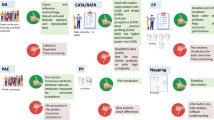Abstract
Sensory evaluations are adopted in many fields for measuring and comparing sensory properties of products and improving their quality. The selection of panelists able to provide precise evaluations is a crucial issue to perform reliable sensory analysis. An agreement-based approach is here suggested in order to assess the quality of sensory data in terms of both panelist repeatability and panel reproducibility. The approach has been applied to two case studies involving untrained sensory panelists and trained teaching quality assessors, respectively. The results of the case studies show that although reproducibility can be assumed moderate for both groups of raters, repeatability is generally higher for the group of trained raters.




Similar content being viewed by others
References
Altman, D.G.: Practical Statistics for Medical Research. CRC Press, Boca Raton (1990)
Bashkansky, E., Dror, S., Ravid, R., Grabov, P.: Effectiveness of a product quality classifier. Qual. Control Appl. Stat. 53(3), 291–292 (2008)
Bi, J.: Agreement and reliability assessments for performance of sensory descriptive panel. J. Sens. Stud. 18(1), 61–76 (2003)
Brennan, R.L., Prediger, D.J.: Coefficient kappa: some uses, misuses, and alternatives. Educ. Psychol. Meas. 41(3), 687–699 (1981)
Brockhoff, P.B.: Statistical testing of individual differences in sensory profiling. Food Qual. Prefer. 14(5–6), 425–434 (2003)
Carpenter, J., Bithell, J.: Bootstrap confidence intervals: when, which, what? A practical guide for medical statisticians. Stat. Med. 19(9), 1141–1164 (2000)
Cicchetti, D.V., Allison, T.: A new procedure for assessing reliability of scoring eeg sleep recordings. Am. J. EEG Technol. 11(3), 101–110 (1971)
Cohen, J.: A coefficient of agreement for nominal scales. Educ. Psychol. Meas. 20(1), 37–46 (1960)
De Mast, J.: Agreement and kappa-type indices. Am. Stat. 61(2), 148–153 (2007)
Erdmann, T.P., De Mast, J., Warrens, M.J.: Some common errors of experimental design, interpretation and inference in agreement studies. Stat. Methods Med. Res. 24(6), 920–935 (2015)
Fleiss, J.L., Levin, B., Paik, M.C.: Statistical methods for rates and proportions. Wiley (2013)
Gadrich, T., Bashkansky, E.: Ordanova: analysis of ordinal variation. J. Stat. Plan. Inference 142(12), 3174–3188 (2012)
Gadrich, T., Bashkansky, E., Zitikis, R.: Assessing variation: a unifying approach for all scales of measurement. Qual. Quant. 49(3), 1145–1167 (2015)
Gardner, M.J., Altman, D.G.: Confidence intervals rather than P values: estimation rather than hypothesis testing. Br. Med. J. (Clin Res Ed) 292(6522), 746–750 (1986)
Geier, U., Büssing, A., Kruse, P., Greiner, R., Buchecker, K.: Development and application of a test for food-induced emotions. PLoS ONE 11(11), 1–17 (2016)
Gwet, K.L.: Handbook of Inter-Rater Reliability: The Definitive Guide to Measuring the Extent of Agreement Among Raters. Advanced Analytics, LLC, Gaithersburg (2014)
Iannario, M., Manisera, M., Piccolo, D., Zuccolotto, P.: Sensory analysis in the food industry as a tool for marketing decisions. Adv. Data Anal. Classif. 6(4), 303–321 (2012)
International Organization for Standardization (ISO). Accuracy (Trueness and Precision) of Measurement Methods and Results Part 1: General Principles and Definitions (5725-1). Geneva: ISO (1994)
Kermit, M., Lengard, V.: Assessing the performance of a sensory panel–panellist monitoring and tracking. J. Chemom. 19(3), 154–161 (2005)
King, M.C., Hall, J., Cliff, M.A.: A comparison of methods for evaluating the performance of a trained sensory panel. J. Sens. Stud. 16(6), 567–581 (2001)
Landis, J.R., Koch, G.G.: The measurement of observer agreement for categorical data. Biometrics 33(1), 159–174 (1977)
Latreille, J., Mauger, E., Ambroisine, L., Tenenhaus, M., Vincent, M., Navarro, S., Guinot, C.: Measurement of the reliability of sensory panel performances. Food Qual. Prefer. 17(5), 369–375 (2006)
Lea, P., Rødbotten, M., Næs, T.: Measuring validity in sensory analysis. Food Qual. Prefer. 6(4), 321–326 (1995)
Ludbrook, J.: Statistical techniques for comparing measurers and methods of measurement: a critical review. Clin. Exp. Pharmacol. Physiol. 29(7), 527–536 (2002)
Lundahl, D.S., McDaniel, M.R.: Use of contrasts for the evaluation of panel inconsistency. J. Sens. Stud. 5(4), 265–277 (1990)
Lundahl, D.S., McDaniel, M.R.: Influence of panel inconsistency on the outcome of sensory evaluations from descriptive panels. J. Sens. Stud. 6(3), 145–157 (1991)
Manisera, M., Piccolo, D., Zuccolotto, P.: Analyzing and modelling rating data for sensory analysis in food industry. Quad. Stat. 13, 68–81 (2011)
Næs, T., Solheim, R.: Detection and interpretation of variation within and between assessors in sensory profiling. J. Sens. Stud. 6(3), 159–177 (1991)
Piggott, J.R.: Design questions in sensory and consumer science. Food Qual. Prefer. 6(4), 217–220 (1995)
Pinto, F.S.T., Fogliatto, F.S., Qannari, E.M.: A method for panelists consistency assessment in sensory evaluations based on the cronbachs alpha coefficient. Food Qual. Prefer. 32, 41–47 (2014)
Rossi, F.: Assessing sensory panelist performance using repeatability and reproducibility measures. Food Qual. Prefer. 12(5), 467–479 (2001)
Schlich, P.: Grapes: a method and a sas® program for graphical representations of assessor performances. J. Sens. Stud. 9(2), 157–169 (1994)
Vanacore, A., Pellegrino, M.S.: Characterizing the extent of rater agreement via a non-parametric benchmarking procedure. In: Proceedings of the Conference of the Italian Statistical Society, pp. 999–1004. Italian Statistical Society (2017)
Vanbelle, S.: Agreement between raters and groups of raters. Ph.D. thesis, Université de Liège, Belgique (2009)
Veall, M.R., Zimmermann, K.F.: Performance measures from prediction–realization tables. Econ. Lett. 39(2), 129–134 (1992)
Acknowledgements
The authors deeply thank the two anonymous referees for their careful reading of the manuscript and helpful suggestions.
Author information
Authors and Affiliations
Corresponding author
Rights and permissions
About this article
Cite this article
Vanacore, A., Pellegrino, M.S. Checking quality of sensory data via an agreement-based approach. Qual Quant 53, 2545–2556 (2019). https://doi.org/10.1007/s11135-018-0807-5
Published:
Issue Date:
DOI: https://doi.org/10.1007/s11135-018-0807-5




